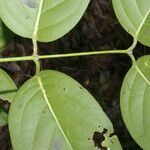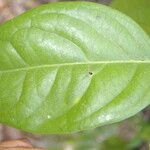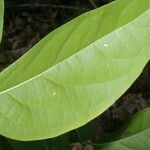Lianas. Branches greyish to purplish brown, smooth, young twigs greenish. Petiole 4-10(-15) mm long; blades chartaceous, light greyish or yellowish green, narrowly elliptic to ovate, (7.5-)9-15(-23) x (3-)5-8(-11) cm, margins entire or slightly crenulate, apex glandular, obtuse or acuminate (acumen 2-12 mm long), base rounded or attenuate, decurrent into the petiole, often somewhat falcate; primary vein prominent above, conspicuously so beneath, secondary veins 5-7 per side, arcuately ascending, prominulous below, tertiary veins reticulate, prominulous on both sides. Inflorescence 5-8(-12) cm long, with up to 7 cm long peduncle, or branched from the base, branches subopposite or alternate; bracts papyraceous, orbicular, 1-1.5 mm long, erosulous; pedicels slender, 2-6 mm long, articulate 1-3 mm below the flower; buds globular. Flowers fragrant, 10-18 mm diam. at anthesis; sepals green, membranous, broadly ovate to deltoid, 1.3-2.5 x 1.7-3.5 mm, entire or erosulous, flabellate-veined; petals white, cream or yellow, membranous, concave, obovate-elliptic, 5-9 x 3.5-8 mm, entire or erosulous; disk green, thin, 0.5 mm high, ca. 3 mm diam., margin undulate; filaments 1 mm long, 1 mm wide at base, becoming reflexed, anthers 0.4-0.6 x 0.8 mm; ovary 0.8-1.6 mm diam., yellowish green, ovules 4(-6) per locule, style stout, 0.5-0.7 mm long, stigmas oblong, 0.4 mm long, obtuse, erect or spreading. Fruiting pedicel to 4 mm diam. Mericarps rounded or broadly obovoid, 5-9.5 x 6-9.5 cm, abruptly stipitate (stipe 1-4 mm), pericarp coriaceous to woody, glaucous green with shallow crimson cracks, less than 1 mm thick; seeds often abortive, embryoniferous part 2-4 x 1.5-2 cm, wing to 5-10(-25) x 5 mm.
More
Liana, the branchlets usually opposite, often rugose, cinereous or brownish. Leaves with the petiole 8-15 mm. long, the blade elliptic-oblong or ovate-oblong, subattenuate and decurrent at the base, gradually acuminate at the apex, entire or obscurely crenulate at the margins, 8-19 cm. long and 4-10 cm. broad, chartaceous, the costa prominent on both surfaces. Inflorescences 5-12 cm. long. Flowers 10-17 mm. in diam.; sepals broadly ovate or ovate-deltoid, subentire or faintly erosulous at the margins, 1.3-2.5 mm. long, usually obviously flabellate-nerved; petals often strongly concave, obovate-elliptic, rounded at the apex, entire or faintly undulate-crenulate and often inflexed at the margins, 5.5-9 mm. long and 3.5-7.5 mm. broad; disc 0.4-0.7 mm. high, membranous; stamens 1.6-2.2 mm. long; ovary 0.8-1.5 mm. in diam., the ovules 4-6 per cell, the style stout, the stigmas conspicuous, spreading, oblong, obtuse. Mericarps depressed-obovate to suborbicular, 5-9 cm. long, 5.5-10 cm. broad and 1-1.5 cm. thick, the pericarp thin-coriaceous; seeds 4-6 per mericarp, the embryoniferous-portion 2-5 cm. long and 1.5-3 cm. broad, the wing about 20-25 mm. long and 5-10 mm. broad distally, coriaceous.
A liana or creeper. The leaves are opposite. The flowering groups are 5-12 cm long. The fruit stalk can be 7 cm long. The fruit is a capsule. There are 3 sections. They are 5-9 cm long by 5-10 cm wide and 1-1.5 cm thick. There are 4-6 seeds. They are 2 cm long and 2 cm wide.



